Hypoallergenic cats and cats: breeds, features of choice and maintenance
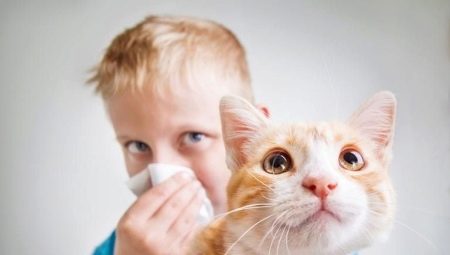
For people with animal allergies, the dream of having a cat remains unrealizable. Many do not know that there are hypoallergenic breeds of these wonderful animals. This article will help you get acquainted with such cats, find out their features and rules of keeping.


Peculiarities
Allergy to animal hair is a problem that is relevant for 1.5% of the world's inhabitants. However, many of them have meowing pets at home. These are representatives of hypoallergenic cat breeds.
The peculiarity of such animals is that their body produces much less protein-antigen Fel D1, which is a strong allergen. This compound is found in the urine and saliva of any cat, so absolutely non-allergenic cats do not exist.
The high concentration of protein, rather than pet hair is commonly believed, causes humans to suffer from an excruciating allergic reaction.
If the amount of antigen in the animal is low, even a fluffy cat is safe for allergy sufferers and asthmatics. Wool only promotes the spread of protein, as clean cats carefully lick themselves. Along with the hair, the allergen is carried through the house, but with a hypoallergenic cat, you will not feel it.
It is believed that light-colored animals do not cause allergies. This is a controversial issue, so you should not pay close attention to the color of the animal.
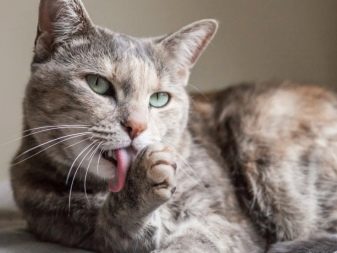
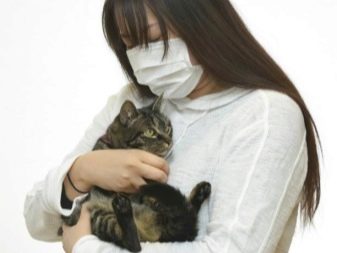
How to choose?
When choosing a cat, be sure to consider the following.
- For asthmatics it is better to have a cat than a cat: the saliva of cats contains much more dangerous antigen. If you choose a boy, the animal should not walk past the litter box and mark in the house. Strictly monitor this or neuter the cat.
- Hairless cats are less allergenic, but require special care and comfortable living conditions.
- Avoid choosing an animal with a thick and dense undercoat to reduce the spread of the allergen in your home.
- When choosing a cat for children, pay attention to breeds that are not prone to aggression. The animal should be condescending to the child's pranks. It is unacceptable for it to scratch and bite children.
- An allergic reaction upon contact with an animal manifests itself after 20-30 minutes, and sometimes after a few days. To understand if a cat can live with you, you need to spend time with her. For this reason, it is better to choose a pet from breeders who will allow you to come into the house and get to know the cat better.
- Don't buy a cat on the market. If you have to part with a new friend, it is not a fact that you can return him to the seller, but you can always agree with the breeder.
- The body of kittens synthesizes much less antigen. When the cat grows up, its number will increase. To be confident in the animal, it is better to take older pets or an adult cat. With a kind attitude, she will quickly get used to you.
- As much as you like a cat, if you feel uncomfortable, do not purchase a pet. This is dangerous for your health.
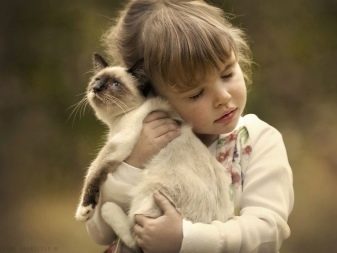
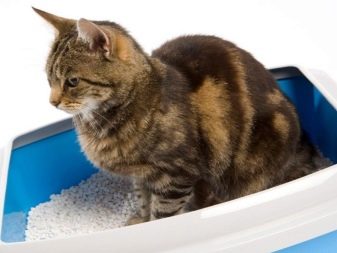
Description of breeds
Siberian
A real Russian beauty - the owner of gorgeous fur, the only long-haired cat that people with allergies can afford.
Scientists have shown that Siberian beauties emit an allergen 20% less than other breeds.
Animals are strong and muscular, rather large. The weight of a Siberian can reach 12 kg. They are excellent hunters, funny playfuls. They are not afraid of dogs, strangers and loud sounds, very obedient and flexible.
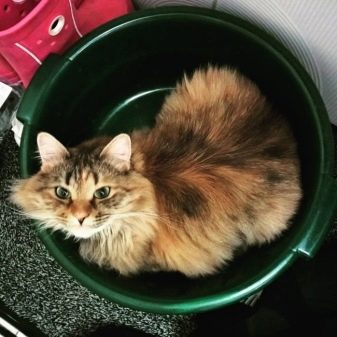
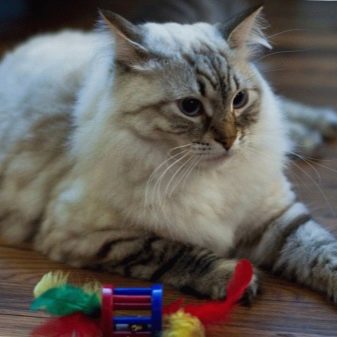
Siberians have excellent health, they do not have hereditary diseases. Picky in food, unpretentious in care. They love affection, but they never impose themselves on the owners.
The color of animals is very diverse:
- blue;
- tortoiseshell;
- tricolor;
- silver;
- White;
- a special color-point is the Neva Masquerade Cat.


Balinese
These wonderful elegant beauties with cornflower blue eyes, reminiscent of Siamese cats in color. A graceful miniature animal with long graceful legs, its movements are similar to the famous dancers from the island of Bali. Hence the name of the breed.
The coat of cats is soft to the touch, without undercoat, it lengthens from head to tail. The Balinese fur coat does not require special care. All you need to care for her is hygiene of the ears, a peephole and regular brushing.
Common color:
- blue point;
- seal point;
- chocolate point;
- frost point.
Their nature is very flexible and sociable. Animals are talkative and affectionate, adore the owner and are ready not to part with him for a minute. They are alien to aggression, so they are ideal pets for young children.
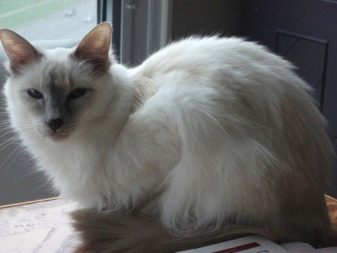
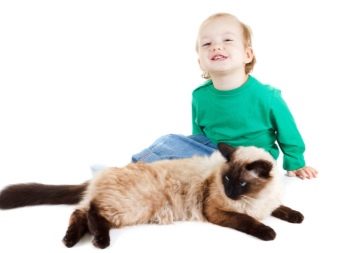
Oriental
These short-haired cuties will easily win the heart of anyone. An elongated slender body on elegant rounded legs, a charming muzzle with large ears and expressive green eyes do not leave cat lovers indifferent.
The shiny, silky hair of the animal fits snugly to the body. The cat has no undercoat, so you need to protect the pet from drafts.

There are more than 300 color variations of the breed.
The most famous:
- blue;
- black;
- White;
- faun;
- cinnamon;
- Havana;
- Red;
- purple.
Grooming for orientals is simple: traditional daily eye and ear treatments, brushing the coat with a rubber glove, and trimming nails regularly.
Breeders recommend feeding your pets premium food, but you can also give them simple food. Fats are very important for animals, they drink milk, but they are prone to overeating and obesity.
Oriental cats are hyperactive and meowing constantly. They need freedom of movement and maximum attention. They are sociable, funny, but touchy.
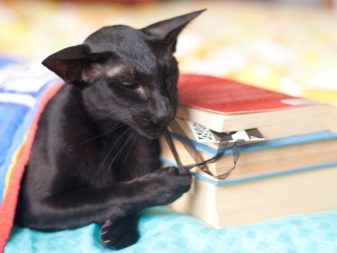
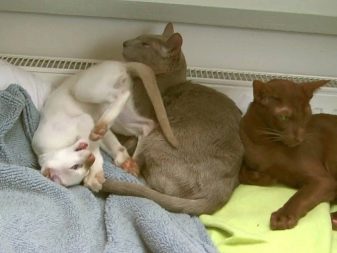
Javanese
This breed is similar in appearance to the oriental one, it differs only in the point color.The animals are lean and fit, with elastic muscles, elegant body lines and long legs. The size of cats is average, the maximum weight is up to 5 kg.
Javanese wool does not need special care: they have no undercoat, the pile is silky and soft. Bathe the animal, brush your teeth, wash your eyes and ears as needed. Cats are prone to hereditary diseases, but with good care they can live up to 15 years.
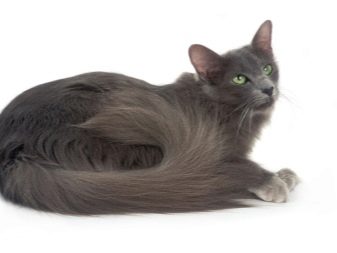
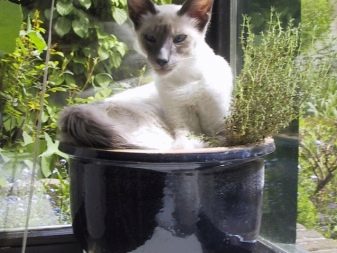
Color:
- ginger;
- cream;
- faun;
- links point;
- party color;
- smoky and silvery point on a white background.
Cats have a sociable character, they get along well with other animals and children. Javanese are temperaments, so take care of wallpaper, flowers and curtains, keep a supply of toys for the cat.
Animals are highly intelligent, can walk on a leash and are trainable. To be everywhere and everywhere with the owner is their main task. Cats do not want to be left alone.
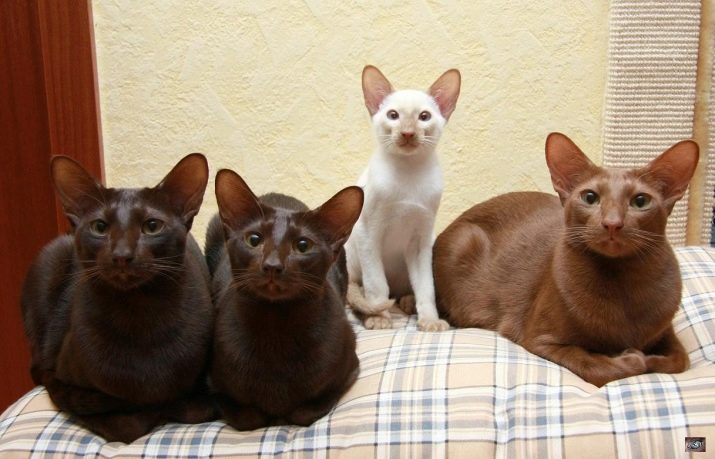
Devon rex
According to the owners, this is not a cat, but just a darling. Both character and appearance satisfy all the requirements. Funny faces with lop-eared ears and huge round eyes - what is not a portrait of aliens! The muscular head rises on a graceful neck. The body is elastic, with a developed chest and high aristocratic legs. A cat can have any color according to world standards.
Animal hair is short and wavy, practically does not fall out, does not cling to clothes and furniture, but gets dirty quickly. Frequent bathing is a pleasure for these cats.
It is necessary to feed astrakhan pets in moderation, they do not feel full. Premium food is great for them.
Devon Rex kittens are the best friends of children, and they simply adore all other family members. Pets have just a dog's loyalty, they are ready to sit at your feet all day, waiting for the next command: they can also be trained.
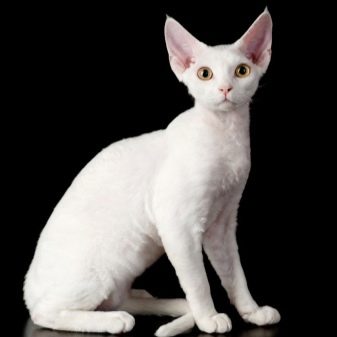
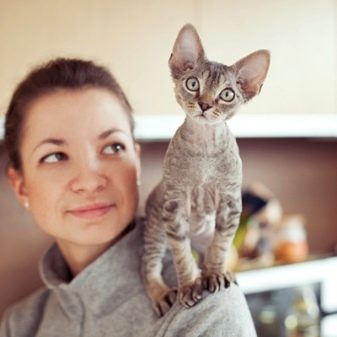
Cornish Rex
No less loved by breeders is the English Cornish Rex with a short curly coat. These pets are adored for their good nature and grace. Cats have no trace of English stiffness. The body of an aristocrat is muscular, with an arched back, high slender legs.
There are various colors. A white cat with a pink nose and pads looks especially cute. Adorable white curly women make him look like a charming lamb.
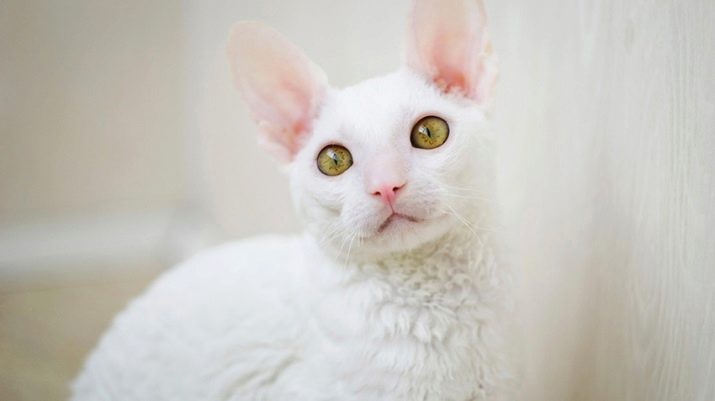
Pets are glad to children, strangers, other animals. Smart, inventive in games, dog-like loyal to humans. They do not bite, do not hurt and do not get angry. If possible, they enjoy spending time with the owner, perching on their necks in the form of a collar or snuggling on their chest instead of a luxurious boa.
The golden quality of this breed is that cats never mark in the house.
Caring for the Corniche is not very troublesome. They bathe their pets 1-2 times a month, regularly clean their eyes, ears and teeth, and comb them. Cats of this breed rarely suffer from serious diseases, they have no genetic diseases. A beloved pet can live for more than 15 years.


Sphinxes
Sphynxes are the leaders on the list of hypoallergenic cats. These are animals with a minimal amount of hair or a complete absence of it, which is gratifying for people suffering from a painful reaction not only to feline protein, but also to animal hair.
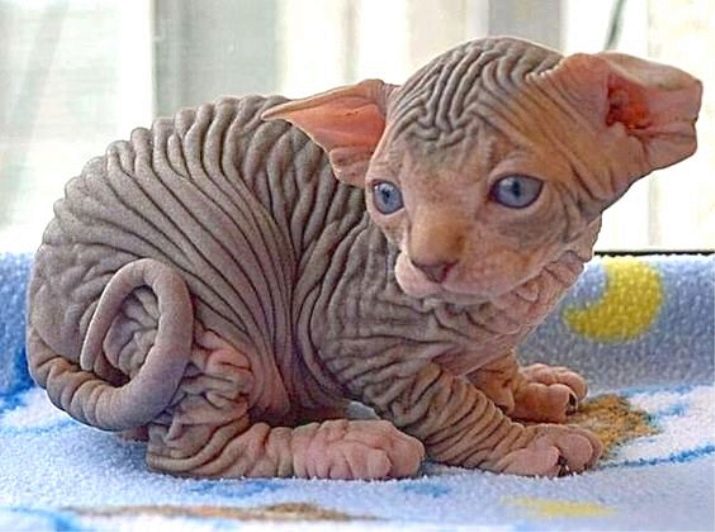
There are several breeds of this type of cat.
Don Sphinx. This cat appeared not so long ago, but has already won numerous admirers. In addition, the "Don Cossack" managed to become the "parent" of another, even younger breed - the St. Petersburg Sphynx.
Sphynxes are cats in a fold. The more wrinkles the better by breed standards.
At the Don Sphynx, they diverge in a beautiful fan from the muzzle under the eyes, gathering in a neat accordion on the forehead.
The ears of the animal are large, rounded. The eyes are slightly half-closed, almond-shaped, and come in any color. The body of the animal is strong, medium in size, harmoniously folded. Ruffled leather on shoulders, legs and abdomen.
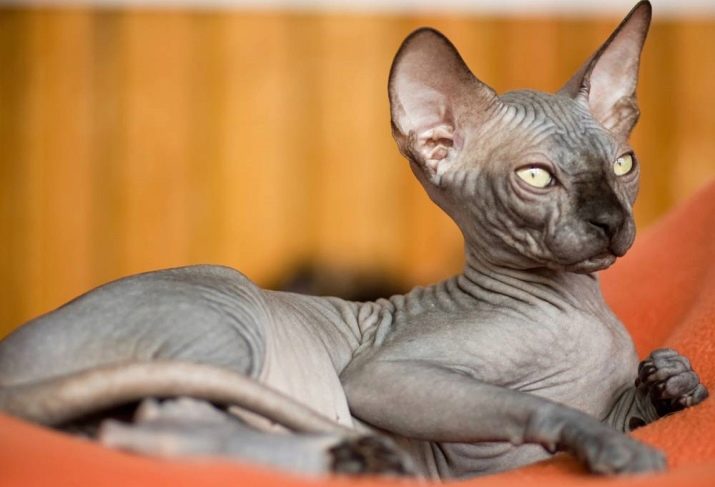
There are 4 types of Canadian sphinxes:
- naked or "rubbery" completely bald;
- velours - there is a delicate fluff on the body;
- flock - animals with pile resembling the fabric of the same name;
- brush - cats in places with thin and coarse wavy hair.
Any color of animals can be found, there are no restrictions on the breed standard here.

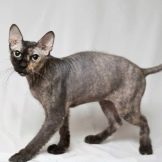

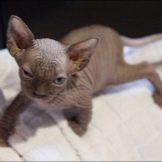
The cat needs attention. Wipe her skin with napkins, if she sweats, bathe often, otherwise the sweat of the animal will stain your clothes and furniture. This is a common feature of all sphinxes.
Pay attention to the smell of the animal. They have a special one, but if the animal is sick, sour notes appear in it.
Cats suffer from dermatitis, eczema, are prone to fungal diseases and conjunctivitis due to the absence of cilia on the eyelids.
Animals are freezing or may be sunburned, so they need clothing. Pet outfits are expensive, so if you know how to sew or knit, your cat will be grateful for the handmade suit.
Cats of this breed are very affectionate. They are ready to bestow their love on the whole world. They love to sit on their knees and on the arms of even complete strangers. They are friends with children and other animals. They are very curious, they climb everywhere and poke their noses.
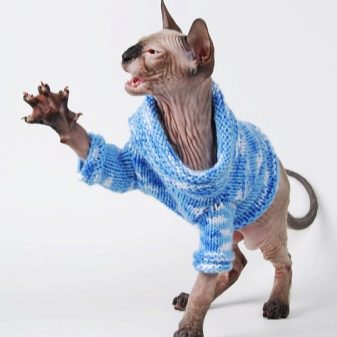
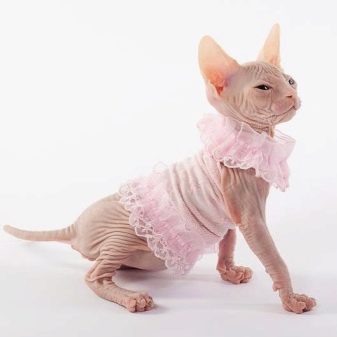
Peterlbold
"Petersburg Sphinx", or "bald Peter", was born in the city on the Neva. It is a rare and graceful breed. Miniature female cats in adulthood weigh about 3.5 kg, and cats gain a maximum of 5 kg. Among the diseases of the Peterbald people there are genetic diseases. Cats live for about 15 years.
The body of the Peterbald is fit and slender, like that of the Don Sphynx, in numerous folds and folds. The skin is hot and elastic, pleasant to the touch.
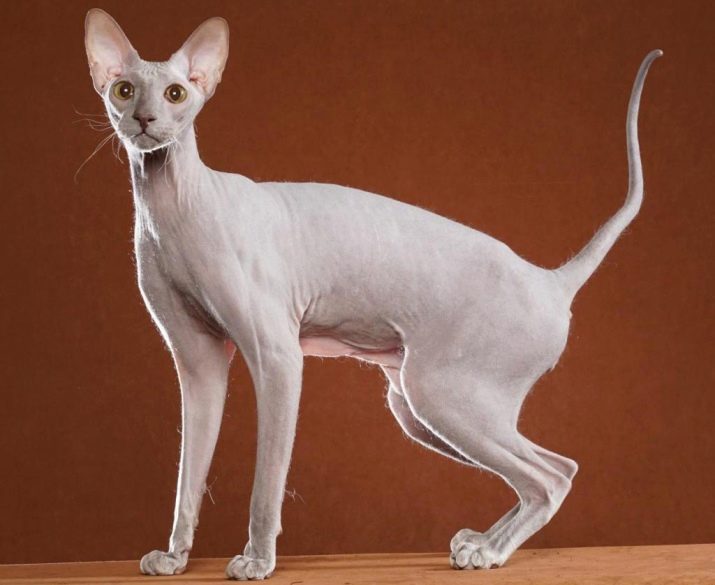
The nature of animals is docile, they are playful and affectionate, absolutely not vindictive. It takes titanic efforts to make an animal mad. The cats are very clean. Appetite, according to the owners, they have excellent, they are unpretentious in food.
Pet care needs daily and thorough. The St. Petersburg Sphynx also sweats, emitting a brown liquid, similar to wax. Cats are regularly wiped with wet wipes and bathed every day, be sure to wash their eyes. Providing your cat with a suitable wardrobe is also essential.
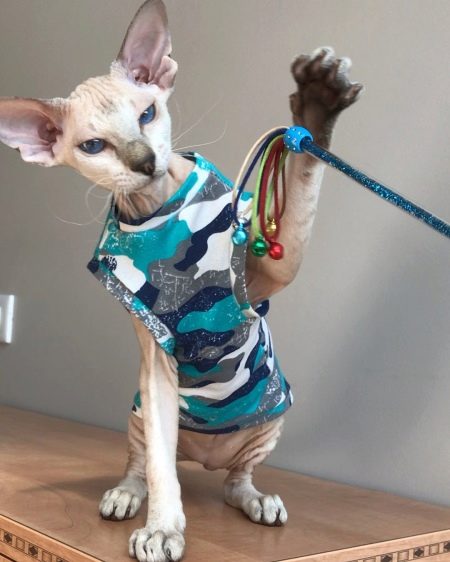
The skin of the breed is different:
- bald- animals completely without hair;
- velours - wool is there in infancy, and with growing up it remains only in certain places;
- brush - an animal is born with wool, and as it grows up, it parts with it;
- brush point - the body of the cat is covered with a thin fur plush.
It is useful for bald cats to sunbathe, their skin takes on a pleasant shade if the tan is moderate.
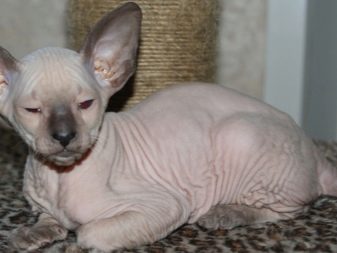
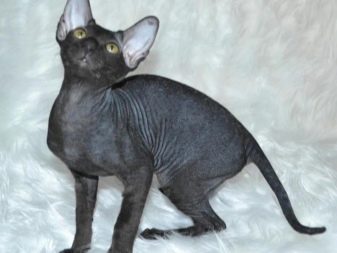
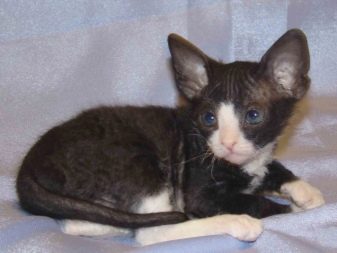
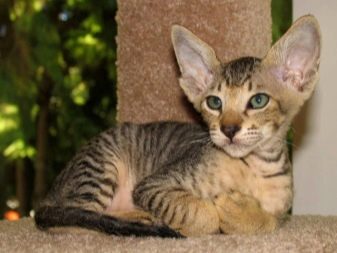
Popular color:
- tortoiseshell;
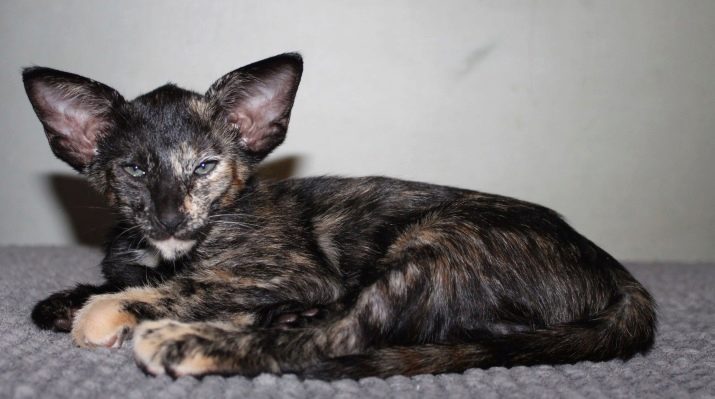
- blue;
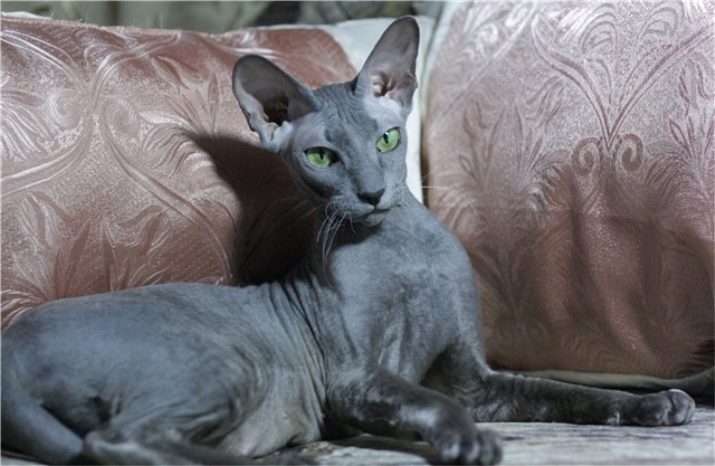
- White.
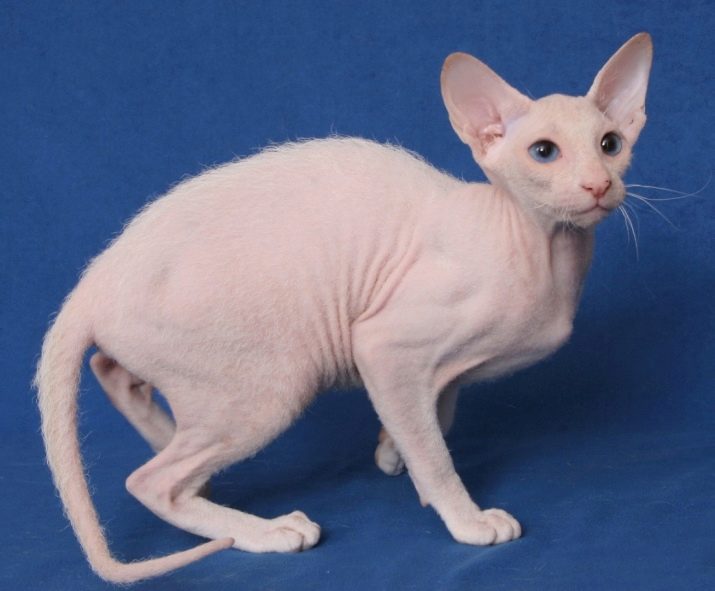
Canadian sphinx
The palm tree among all hypoallergenic cat breeds belongs to the Canadian Sphynx. They do not shed and synthesize the least amount of protein. Communicating with him, you definitely won't have to drink antiallergenic drugs.
These are graceful cats, whose body does not have sharp corners, it is created from smooth lines. Long, flexible and streamlined - this is how you can describe them.
The head of the animal is medium in size, triangular in shape with large ears and almond-shaped eyes. The difference between Canadians and other bald sphinxes is that they have very long legs with "monkey" toes, large claws and a record number of folds on the skin. They should be present on the legs, back, shoulders, neck and head of the cat.
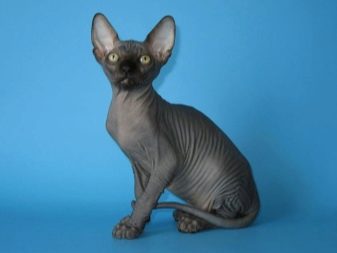
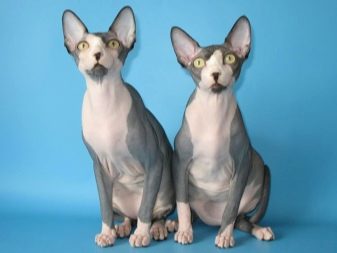
Popular colors:
- ginger;
- Gray;
- black;
- White;
- chocolate;
- lilac;
- faun;
- tortoiseshell;
- cinnamon.
Sphynx owners admire their pets. According to them, they are smart, kind, cheerful and sociable. They are unsurpassed playfuls, singers and talkers. And their desire to be fondled simply goes beyond the bounds of decency and becomes obsessive.
Animals are ready to get off their hands for hours, whether you are a family member or a guest. There is no sweeter pleasure for them when they scratch behind a lop-eared ear. However, animals are loyal to their family and owners.
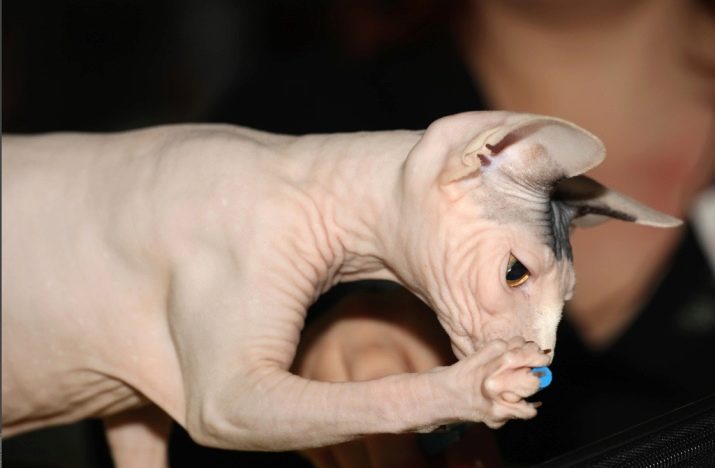
Cats are mobile, run around the house with toys, climb to the tops of cabinets and shelves. Pride will not allow them to grab food from the table, but turning your things into toys is easy. Animals do not have the habit of spoiling things, but they can damage them with their claws, so cutting them is an obligatory ritual. Remember to clean and wash your pet's ears and eyes.
As the Don and St. Petersburg counterpart, the Canadian must be bathed frequently, washing off the dark sweat from the animal's body, otherwise it will dry out and turn into a hard-to-wash “tan”. You can bathe cats with any baby shampoo. Always keep wet wipes nearby to clean your pet.
It is advisable to periodically walk with the cat in the sun. The Sphinx willingly walks in a harness on a leash.
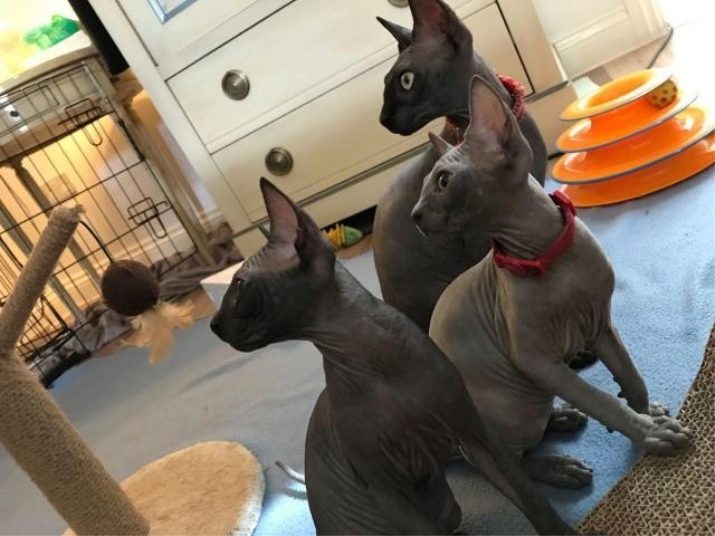
Cats have a good appetite, they are omnivorous, but they do not chew food well. If you are going to cook for the cat yourself, grind the food so that the cat can easily eat it. It is better to feed Canadians with lean meat, although they can sweep away everything: cheese, chocolate and any dessert. Among them there are gourmets who eat sauerkraut, fresh cucumbers and melons.
Canadians are prone to obesity and various dermatitis, diseases of the oral cavity. You need to be attentive to their health and regularly see a veterinarian.
Content rules
Keeping hypoallergenic pets properly is a guarantee that you will live a long and happy life together. If all the rules for caring for a cat are followed, the animal will be healthy, and your loved ones will not suffer from painful allergy symptoms.
To keep the allergic person in good health near the cat, it is necessary to maintain a reduced amount of the released allergen:
- be sure to bathe your cat as recommended for its breed;
- rinse the animal after washing with cool water, but very carefully so that the cat does not get sick;
- wash your pet's toys daily;
- the bedding on the sleeping place of the animal must be vacuumed daily;
- the cover on the cat bed should be removable and easy to wash;
- clean up the mess in the cat's dining room;
- wash the dishes of the animal after each meal;
- remove the tray in time and keep it always clean.


A few tips will help you follow the rules for keeping the animal.
- To avoid problems, take the time to properly nurture your kitten. Immediately teach your cat not to jump on the dining table, not to climb into bags of groceries, not to sleep on your pillow.
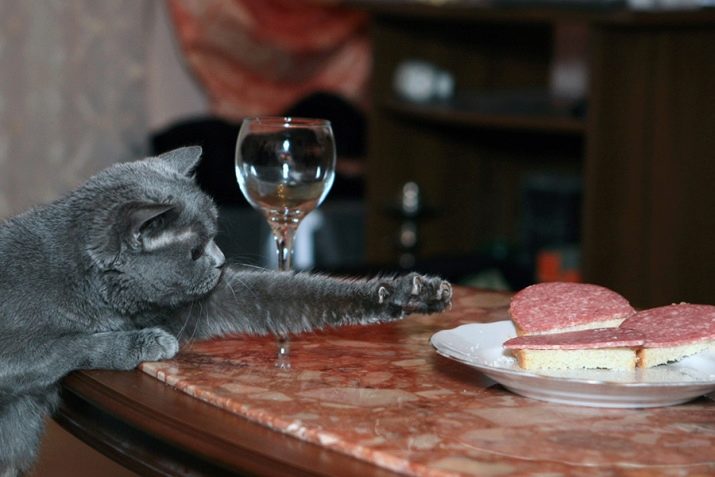
- It is your sacred duty to accustom the animal to bathing. Even if this procedure is unpleasant for the pupil, and burdensome for you, you need to wash the cat regularly.
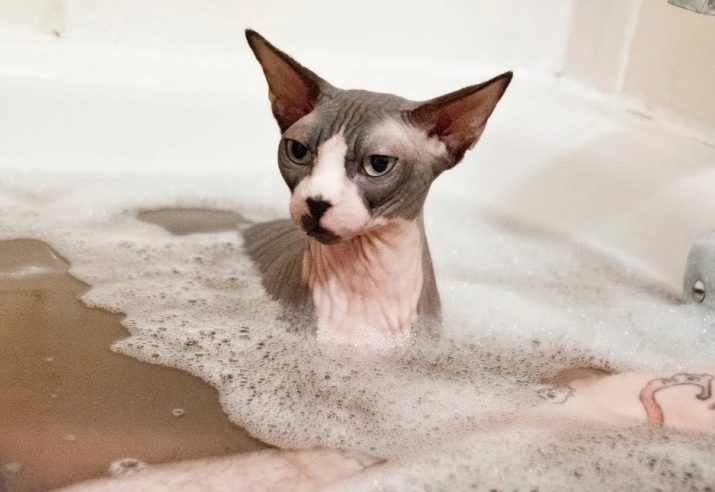
- Connect your loved ones who do not suffer from allergies to help yourself, purchase special shampoos that reduce protein secretion... For hairless cats, use wet wipes with a similar effect.

- Brush the animal more often, and remove the cat's hair immediately. Purchase special combs for your pet, get him personal bath towels.

- All bath accessories are carefully wash and store separately from your belongings.

- The litter in the cat's tray should be of high quality, quickly absorbent... It should not cling to the body of an animal and spread throughout the house.

- Do not buy stuffed animals for your cat. They absorb the animal's saliva, and with it the allergen, when the cat bites them or carries them in the mouth. Toys should wash well and dry quickly.

- Do not forget to regularly take your pet for a routine examination to the doctor, get vaccinated on time.

- If the cat is sick, you cannot hesitate to visit the doctor.... Not only the life of the animal will be in danger, but also yours: a sick cat emits an allergenic antigen much more than usual.
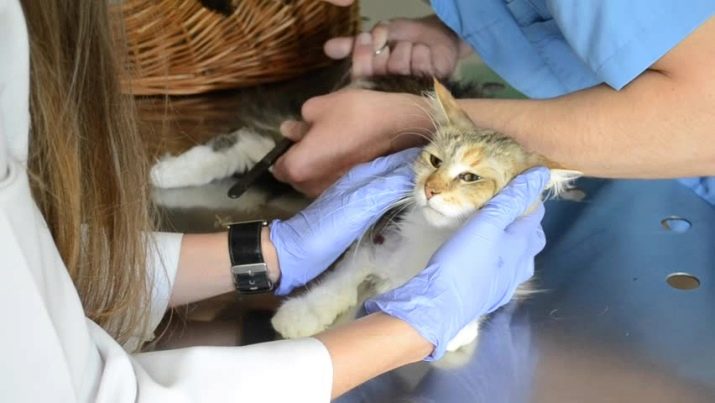
- Keep your home clean and tidy. Wet mop every day, especially where your pet spends more time.

- Follow the rules of personal hygiene. Always wash your hands after handling an animal. Don't bring them to your face, rub your eyes, or scratch your nose if you've just petted a cat.

Treat your cat with care and love.
In the video you can watch an overview of the breeds of hypoallergenic cats.

































Siberian cats can cause allergic reactions, but not all. We have long wanted to buy a hypoallergenic kitten, but we could not decide on the breed. Now we have a wonderful Siberian kitten! And it does not cause allergies.